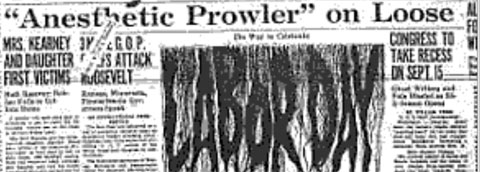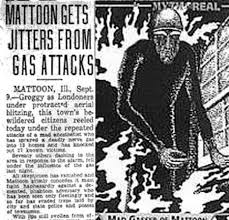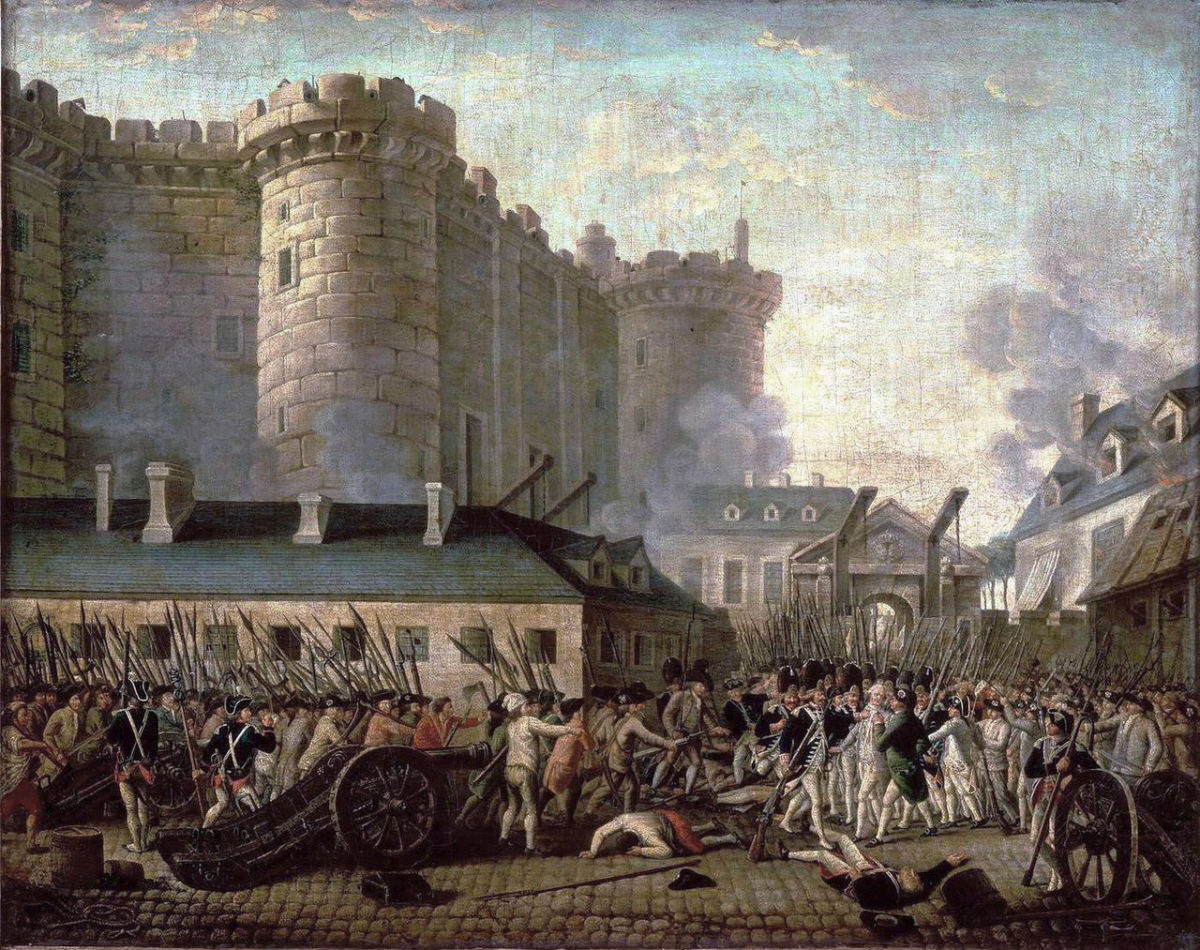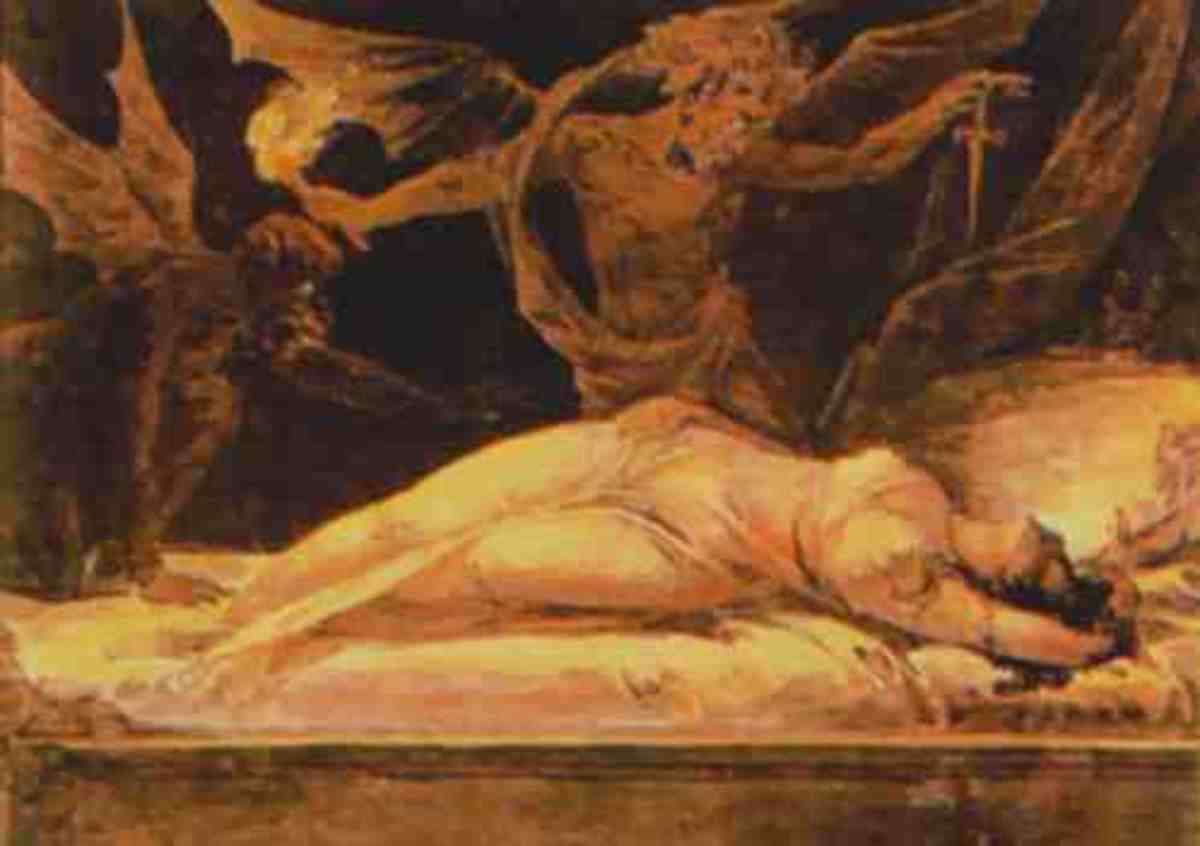The Mad Gasser!
The sickly sweet smell filled the bedroom. Mrs Kearney, a Mattoon, Illinois housewife, first believed the smell to be the scent of flowers wafting in from the summer night outside . Next to her Dorthy, her three year daughter, began coughing. She later told a reported from the Mattoon Journal-Gazette " ...the odor grew stronger and I begun to feel a paralysis of my legs and lower body." The paralysis would pass after a half hour and next day Aline mostly complained of burned lips and a badly parched mouth and throat.
Frighted, Aline began screaming, unable to move her legs, drawing the attention of her neighbors and her sister in the next room. As the neighbors search the Kearney yard and the rest of the neighborhood, while waiting for police to arrive. No-one found anything. Although when Mr Kearney arrived home from work at around mid-night, an hour and a half after the attack, he described a stranger "...tall, dressed in dark clothing and wearing a tight-fitting cap."
Mr Kearney approached and the prowler fled. Mr Kearney gave chase, but was unable to capture the man.This "dark figure would soon come to be known as the Mad Gasser of Mattoon, and this ambiguous individual would be blamed for dozens of such attacks in the following weeks."

The next day the Journal-Gazette broke the story of the "Anesthetic Prowler", referring to Aline Kearney and her daughter as the first victims and saying "...there would more victims", opening itself "...to controversy and severe criticism." Mattoon, Illinois, summer 1944, was a "typical, peaceful little Midwestern City {population 15,827 in the 1940 census}".
The newspaper story brought other victims. Mrs Kearney was not the first, A few days before the Kearney attack, on Aug 31st, two other households, a married couple and a woman and her daughter. suffered similar attacks. "Lightheadedness, paralysis, upset stomach, and vomiting, accompanied by a sickly-sweet odor."
By the evening of September 5th, there of reported of at least four more "gas attacks". That night, around 10:30, Beulah Cordes and her her husband Carl returned home from an evening out. While Carl unlocked the door, Beulah spotted a white cloth on the porch. Curious, she picked it up and noticed it was damp. She later said, "...when I inhaled the fumes from the cloth, I had a sensation similar to coming in contact with a strong electric current.
The feeling raced down my body to my feet and then seemed to settle in my knees...a feeling of paralysis..." She vomited and her lips and face began swelling and burning, her mouth bleeding, She soon lost the ability to speak. The conditions began fading within two hours.
Matoon police found a skeleton key and an empty lipstick tube also on the Cordes porch, deciding a prowler had been interrupted by the couple as he trying to break into the home. The cloth "was sent to chemists at the University of Illinois for analysis."
Soon, the police were handling several assaults a night,including an attack on another housewife the same night as the Cordes. "Many victims reported a tall figure dressed in black fleeing from their property immediately after the attacks, as well as blue vapors and buzzing sounds." By September the 8th, the Decatur Herald reported "...twelve persons in the last week have been visited by the nocturnal prowler who shoots an unidentified chemical into bed chambers through open windows...in all sections of Mattoon."

Lots of theories popped up of course. The Illinois States Attorney W.K. Kidwell began checking the state mental hospitals for recently released inmates. The Mattoon police commissioner theorized the prowler might be a "eccentric inventor" testing a new weapon on locals. Maybe Nazis testing chemical weapons. Another suggestion was the attacker was an "ape-man". Analysis of Mrs Cordes cloth showed that" the 'gas' left no traces."
Six more attacks on the night of September 9th, including one couple who arrived home and discovered the entire farmhouse filled with the sickening gas. The next morning Police Commissioner Wright released a statement, warning the populace "...no doubt a gas manic exists and has made a number of attacks, but many...are nothing more then hysteria. Fear of the gas man's entirely out of proportion to the menace of the relatively harmless gas he is spraying...the whole town is sick with hysteria and last night it spread out into the country."
Newspapers began adopting a more skeptical tone and "police now openly suggested...to those who reported being attacked that they were imagining things." All calls on the night of the 11th were dismissed as false alarms The following day, Police Chief Cole held a press conference, announcing the case solved and saying," It was a mistake from beginning to end...we find absolutely no evidence to support stories that have been told." and threatened "to arrest anyone else who reported a gassing without submitting to a medical examination."

Hysteria must be blamed for such seemingly accurate accounts of supposed victims. However, we have found that large quantities of carbon tetrachloride are used in war work done at the Atlas Imperial Diesel Engine Company plant...an odor which can be carried to all parts of the city as the wind shifts."
The plant quickly responded," We use tetrachloride at the Atlas plant only in fire extinguishers. Tetrachloride gas...is odorless and produces no ill effects in the air."
And the Decatur Review pointed out "...no explanation of why several screens had been cut prior to the reported gassings by several persons...Many persons wondered why the odor from the Atlas Diesel plant hasn't caused illness among the townspeople before..."
"The last reported attack occurred on September 13th. Mrs. Bertha Burch said "a woman dressed in mans clothing" sprayed gas into her bedroom and the next morning her son "found imprints of high-heeled shoes on the ground by the bedroom window."
The case and headlines faded. The victims recovered, with no lingering aftereffects. The incidents was "cited in college psychology classes as a perfect example of mass hysteria. Occurring during World War II, when so many men were off fighting...women were left alone, the gassings...explained away as the product of paranoia, panic and delirium."
In 2003, Scott Maruna, a high school teacher in living Jacksonville, Illinois and raised in Matoon, , wrote his book The Mad Gasser of Mattoon: Dispelling the Hysteria. "Mr. Maruna examines the 11 traits common to mass hysteria, providing factual details to subvert each of these characteristics. For example, most mass hysteria cases involve women, as did the Mattoon gassings." Maruna points out, this occurring at the height of WW11 "Mattoon would have naturally had more women in residence; therefore, the victims would obviously include more females."
He ends up dismissing the hysteria claim and instead names a suspect, Farley Llewellyn. Llewellyn, a"local genius", who worked at his family's grocery store. An accomplished chemistry student at the University of Illinois at the time, he was also an alcoholic and homosexual, which made him an outcast in the small town. "kept a secret laboratory, and experimented with various chemicals." The laboratory once exploded, terrifying the entire neighborhood. He attended high school with the first victim. The police even briefly placed him under surveillance, but he charges never came. Matura theorizes that Llywellyn's two sisters may have performed a couple of the gassings themselves, drawing suspion away from their troubled brother. That would explain the high-heeled footprints found outside Mrs. Burch's bedroom window.
sources: Bellows, Allan. "The Mad Gasser of Mattoon." • Damn Interesting. N.p., Dec. 2005. Web. 21 May 2015.
Coleman, Loren- Mysterious America New York: Paraview 2004
Klickna, Cinda. "The Case of the Mad Gasser of Mattoon." The Case of the Mad Gasser of Mattoon. IlllnoisTimes, 1 May 2003. Web. 21 May 2015. <http://illinoistimes.com/article-70-the-case-of-the-mad-gasser-of-mattoon.html>.








